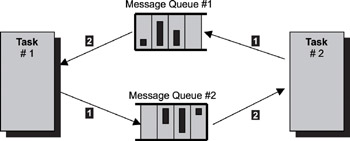Книга: Real-Time Concepts for Embedded Systems
15.3 Communication
15.3 Communication
Tasks communicate with one another so that they can pass information to each other and coordinate their activities in a multithreaded embedded application. Communication can be signal-centric, data-centric, or both. In signal-centric communication, all necessary information is conveyed within the event signal itself. In data-centric communication, information is carried within the transferred data. When the two are combined, data transfer accompanies event notification.
When communication involves data flow and is unidirectional, this communication model is called loosely coupled communication. In this model, the data producer does not require a response from the consumer. Figure 15.4 illustrates an example of loosely coupled communication.

Figure 15.4: Loosely coupled ISR-to-task communication using message queues.
For example, an ISR for an I/O device retrieves data from a device and routes the data to a dedicated processing task. The ISR neither solicits nor requires feedback from the processing task. By contrast, in tightly coupled communication, the data movement is bidirectional. The data producer synchronously waits for a response to its data transfer before resuming execution, or the response is returned asynchronously while the data producer continues its function.

Figure 15.5: Tightly coupled task-to-task communication using message queues.
In tightly coupled communication, as shown in Figure 15.5, task #1 sends data to task #2 using message queue #2 and waits for confirmation to arrive at message queue #1. The data communication is bidirectional. It is necessary to use a message queue for confirmations because the confirmation should contain enough information in case task #1 needs to re-send the data. Task #1 can send multiple messages to task #2, i.e., task #1 can continue sending messages while waiting for confirmation to arrive on message queue #2.
Communication has several purposes, including the following:
· transferring data from one task to another,
· signaling the occurrences of events between tasks,
· allowing one task to control the execution of other tasks,
· synchronizing activities, and
· implementing custom synchronization protocols for resource sharing.
The first purpose of communication is for one task to transfer data to another task. Between the tasks, there can exist data dependency, in which one task is the data producer and another task is the data consumer. For example, consider a specialized processing task that is waiting for data to arrive from message queues or pipes or from shared memory. In this case, the data producer can be either an ISR or another task. The consumer is the processing task. The data source can be an I/O device or another task.
The second purpose of communication is for one task to signal the occurrences of events to another task. Either physical devices or other tasks can generate events. A task or an ISR that is responsible for an event, such as an I/O event, or a set of events can signal the occurrences of these events to other tasks. Data might or might not accompany event signals. Consider, for example, a timer chip ISR that notifies another task of the passing of a time tick.
The third purpose of communication is for one task to control the execution of other tasks. Tasks can have a master/slave relationship, known as process control. For example, in a control system, a master task that has the full knowledge of the entire running system controls individual subordinate tasks. Each subtask is responsible for a component, such as various sensors of the control system. The master task sends commands to the subordinate tasks to enable or disable sensors. In this scenario, data flow can be either unidirectional or bidirectional if feedback is returned from the subordinate tasks.
The fourth purpose of communication is to synchronize activities. The computation example given in 'Activity Synchronization' on section 15.2.2, shows that when multiple tasks are waiting at the execution barrier, each task waits for a signal from the last task that enters the barrier, so that each task can continue its own execution. In this example, it is insufficient to notify the tasks that the final computation has completed; additional information, such as the actual computation results, must also be conveyed.
The fifth purpose of communication is to implement additional synchronization protocols for resource sharing. The tasks of a multithreaded program can implement custom, more-complex resource synchronization protocols on top of the system-supplied synchronization primitives.
- Integrated Secure Communications System
- The Impossibility of Communication
- PROJECT 6.10 — Serial Communication–Based Calculator
- Using Software-Based Serial Communication
- 8.3 USB Bus Communication
- 2.5. GROUP COMMUNICATION
- 2.5.1. Introduction to Group Communication
- 2.5.3. Group Communication in ISIS
- 4.6.3. Real-Time Communication
- 7.5. COMMUNICATION IN AMOEBA
- 7.5.2. Group Communication in Amoeba
- 8.4. COMMUNICATION IN MACH




